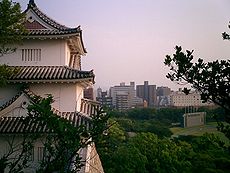Akashi Castle
This article needs additional citations for verification. (March 2022) |
| Akashi Castle | |
|---|---|
明石城 | |
Important Cultural Properties of Japan
 |
Akashi Castle (明石城, Akashi-jō) was an
History
Akashi Castle is located on Mount Akamatsu, a hill in central Akashi, to the north of
The construction of the castle was by order of
The castle only took one year to complete, which was relatively fast for the time period.[3] This was done so quickly as a result of the 1615 decree mandating castle per clan, so many castles in the area were dismantled and some materials and buildings were recycled for the construction of Akashi Castle. This included wood from Miki Castle, Takasago Castle, Edayoshi Castle, and Funage Castle and a number of buildings from Fushimi Castle and Funage Castle including yagura towers. Although no tenshu main tower was ever built, Akashi Castle became a large castle with 20 yagura and 27 gates. The Inner bailey had four three-story corner yagura, two of which have survived to the present.[2]
The Ogawasawa clan were transferred to
Akashi Castle was listed as one of
The castle is a ten-minute walk from
Gallery
-
Layout map
-
Section of wall and the Hitsujisaru Yagura
-
Tatsumi Yagura
Cultural properties

Two of the remaining yagura towers of Akashi Castle have been designated
See also
Further reading
- De Lange, William (2021). An Encyclopedia of Japanese Castles. Groningen: Toyo Press. pp. 600 pages. ISBN 978-9492722300.
- Schmorleitz, Morton S. (1974). Castles in Japan. Tokyo: Charles E. Tuttle Co. pp. 144–145. ISBN 0-8048-1102-4.
- Motoo, Hinago (1986). Japanese Castles. Tokyo: Kodansha. p. 200 pages. ISBN 0-87011-766-1.
- Mitchelhill, Jennifer (2004). Castles of the Samurai: Power and Beauty. Tokyo: Kodansha. p. 112 pages. ISBN 4-7700-2954-3.
- Turnbull, Stephen (2003). Japanese Castles 1540-1640. Osprey Publishing. p. 64 pages. ISBN 1-84176-429-9.
References
- ^ "明石城跡". Cultural Heritage Online (in Japanese). Agency for Cultural Affairs. Retrieved 15 September 2021.
- ^ ISBN 978-4311750403.(in Japanese)
- ^ a b "Akashi Castle – Jcastle.info". jcastle.info. Retrieved 5 March 2022.
- ^ Japan Castle Foundation
- ^ "明石城 坤櫓". Cultural Heritage Online (in Japanese). Agency for Cultural Affairs. Retrieved 15 September 2021.
- ^ "明石城 巽櫓". Cultural Heritage Online (in Japanese). Agency for Cultural Affairs. Retrieved 15 September 2021.
External links
![]() Media related to Akashi Castle at Wikimedia Commons
Media related to Akashi Castle at Wikimedia Commons




